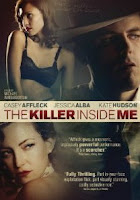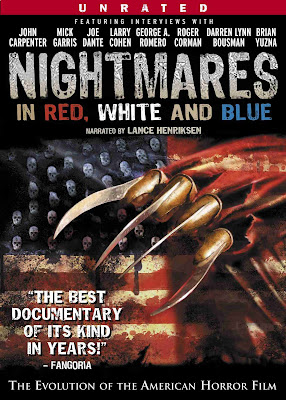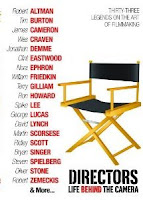My Son, My Son, What Have Ye Done? (First Look)
Standard list price: $18.99
Release date: Sept. 14
The Killer Inside Me (MPI)
SLP: $13.99
Release date: Sept. 28
Two movies by major filmmakers exploring the minds of killers debuted on DVD recently, and the results are so divergent they might as well be filed under different categories in the video store. The first of these, My Son, My Son, What Have Ye Done? is the latest gonzo feature from Werner Herzog, shot for about 20 bucks for David Lynch’s production company. A couple of weeks later, the more high-profile film, The Killer Inside Me, hit shelves as the second film adaptation of Jim Thompson’s pulp classic of the same name.
For many cinephiles, the Herzog-Lynch coproduction is a match made in disturbia, and indeed, the final product suggests the macabre weirdness of both. It begins as an audience-winking police procedural not unlike Herzog’s more widely distributed 2009 film, Bad Lieutenant: Port of Call – New Orleans, with police detectives played by Willem Dafoe and Michael Pena called to investigate a murder in a suburban home. But the story soon focuses on Michael Shannon’s Brad McCullum, the killer. We discover within 10 minutes that Brad, an actor in a local production of Aeschylus’ Greek trilogy Oresteia, murdered his mother with the antique sword that served as the play’s prop.
Mystery solved, the story becomes a matter of luring Brad from his tacky Southwestern-designed home, wherein he claims he’s holding hostages. From this point on, the plot is rather conventional: The detectives interview the people close to Brad, from fiancée Chloe Sevigny to theater director Udo Kier, whose stories Herzog reveals in a series of flashbacks that lead to Brad’s psychotic episode. We learn that Brad’s mother (Grace Zabriskie) is a skin-and-bones freakshow right out of Eraserhead, concocting hideous gelatins and infantilizing her clingy son, resulting in Brad’s Oedipus-meets-Norman Bates response. An adventurous trip to a Peruvian rainforest, meanwhile, sees Brad’s conversion to Islam, as he attains a sort of a spiritual nirvana when he forecasts the accidental deaths of his companions. Later, we see him obtain the murder weapon from his uncle, a backwoods, ostrich-raising rancher portrayed by a sufficiently crazed Brad Dourif.
Borrowing liberally from the real-life story of a San Diego man who stabbed his mother with a saber in a slaying inspired by the same Greek tragedy, Herzog casts a peculiar comic spell that runs counter to the film’s now conventional Citizen Kane-like structure. Brad ’s mental breakdown is also the film’s comedic apex: He shows up at an army hospital declaring that he wants to help “the sick,” an unsubstantiated request that baffles everyone at the hospital. “The sick. In general,” is his only clarification.
’s mental breakdown is also the film’s comedic apex: He shows up at an army hospital declaring that he wants to help “the sick,” an unsubstantiated request that baffles everyone at the hospital. “The sick. In general,” is his only clarification.
Shannon seems to be channeling Brecht more than Aeschlyus, acknowledging the camera’s presence in oddball self-referential asides that seek to hijack the narrative at hand. This tendency, combined with the drained-out color scheme – the film looks as if someone poured bleach all over the master print – all help to assert this minimalist anti-thriller’s compelling but limited appeal as a strict niche film for Herzog and Lynch devotees.
Herzog’s recent m.o., exemplified by My Son, My Son, is the rejection of realism. The Killer Inside Me, Michael Winterbottom’s take on Jim Thompson’s cult book, takes the opposite approach, even when the source material doesn’t warrant it. Where Herzog’s film is a bloodless psychological journey into a sick mind, Winterbottom’s Killer, about a small-town sheriff (Casey Affleck) who flies off the deep end after involving himself with a blackmailing prostitute, is a gory descent into a sick mind, garnering some controversy for the brutally realistic pummeling of its two chief female characters, Jessica Alba’s Joyce Lakeland and Kate Hudson’s Amy Stanton.
A cold-blooded neo-noir despite its sun-baked desert settings, The Killer Inside Me is a faithful adaptation of Thompson’s text with a major climactic exception: Winterbottom films the action too literally, achieving none of the existential, open-ended insanity that left the thrilling novel open to interpretation. Events that may have conspired only in the killer-narrator’s mind are rendered onscreen as fact, even if they come across as patently ludicrous. Moreover, the wicked humor that characterized the book is all but absent from Winterbottom’s morose vision. He could learn a thing or two from Herzog’s approach – movies about psychopaths don’t have to be mirthless.

Nightmares in Red, White and Blue (Kino)
SLP: $26.99
Release date: Sept. 28
Directors: Life Behind the Camera
SLP: $21.99
Release date: Sept. 21
Two DVDs about movies hit stores recently, one analyzing film from the theory and criticism perspective and the other from the production standpoint. Nightmares in Red, White and Blue narrows its focus on the evolution of the American horror film, drawing on top filmmakers and experts to help justify the artistry of a genre that for many is still rooted in B-movie kid’s stuff.
Director Andrew Monument traces the lineage of the American horror film, connecting it the real-life barbarity of World War I, the apocalyptic anxiety of the Cold War era, the expansion of women’s rights, the excesses of the 1980s, the self-reflexivity of the ‘90s and the torture porn of the ‘00s. The film rightly identifies horror films as social, cultural a nd political barometers for the country at large, but Monument sometimes goes too far: It’s funny and observant when a mention of Richard Nixon’s silent majority segues into a discussion of Dawn of the Dead, but when a theorist considers Freddy Kreuger to be the fictional embodiment of Ronald Reagan, it’s a bit much.
nd political barometers for the country at large, but Monument sometimes goes too far: It’s funny and observant when a mention of Richard Nixon’s silent majority segues into a discussion of Dawn of the Dead, but when a theorist considers Freddy Kreuger to be the fictional embodiment of Ronald Reagan, it’s a bit much.
Directors: Life Behind the Camera, compiled by the American Film Institute, is not so much a documentary as it is an instruction manual for aspiring filmmakers. With four hours of material stretched over two discs, this completely interactive experience lets viewers select both the topic – from “humble beginnings” to screenwriting to working with actors to financing – and up to 30 filmmakers within that topic, who dispense their knowledge in bite-sized, two-to-five-minute chunks.
Which means that if you’re like me, you’ll love the option to skip over the Chris Columbus, Rob Reiner and Penny Marshall comments and jump right to the Terry Gilliam, David Lynch and Martin Scorsese material. This is an indispensable resource.

The Oath (Zeitgeist)
SLP: $19.99
Release date: Sept. 28
The second in filmmaker Laura Poitras’ unofficial trilogy of post-9/11 documentaries, The Oath surpasses its predecessor – My Country, My Country, a film about the trials of a Sunni doctor running for office in the new Iraqi government – in its ambiguous moral center, grand sweep and savvy storytelling acumen.
The subjects are two former Jihadist warriors recruited by Osama bin Laden prior to the Sept. 11 attacks: Abu Jandal, bin Laden’s onetime bodyguard and now a chatty taxi driver in Yemen; and bin Laden’s chauffeur Salim Hamdan, whom you may remember as the first suspect to face United States military tribunals after being shuttered in Guantanamo Bay for nearly seven years without a trial. Poitras’ structure creates surprises around every corner, crafting her documentary in the shell of the thriller: She cuts between the controversy surrounding Hamdan’s tribunal and sentencing and his brother-in-law Jandal’s day-to-day rituals as an international spokesman of jihad turned Western-media-loving guru – and she also jumps back and forth in time between unearthed al-Qaida videos, her modern fly-on-the-wall reportage and Jandal’s gradual timeline of perceived change of heart after a three-year-prison sentence (during which 9/11, an attack he once supported only to later condemn, took place).
Many themes, from an examination of the Bush administration’s misguided “enhanced interrogation techniques” to a look at the rigid theologies of Sharia law, orbit around this film’s central satellite, a questioning of the possibility of change and redemption, even for one of Islamic jihad’s true believers. You leave this conversation-sparking film with a lot of questions, and Poitras, to her credit, doesn’t poison the debate with her own opinions.

Conceiving Ada (Microcinema)
SLP: $17.99
Release date: Sept. 28
Conceiving Ada, the experimental 1997 feature debut by video artist Lynn Hershman Leeson, may boast the historical footnote of being the first movie to employ virtual sets, but today Leeson’s feminist science-fiction snoozer comes off impossibly dated – the product of a mind rooted in muddled ‘80s fascinations of the omniscient perils of technology and pre-Internet global connectivity. The confounding progeny of Sally Potter and David Cronenberg, Conceiving Ada borrows liberally from both while channeling the passion and drive of neither. Francesca Faridany stars as Emmy, a modern-day “computer genius” who has developed a way to communicate with figures of the past through computer waves. She eventually manages to speak directly, and through, Ada Byron King (Tilda Swinton, compelling even when she reads a phone book, as the cliché goes), the real-life Victorian countess who first developed the idea of a computer language. The film exists somewhere between stilted historical biography and stilted tech fantasy, as emotionally hollow as it is intellectually ludicrous. This dreck is so pretentious it resembles a parody of a self-absorbed art film, its fruits hardly worth the director’s seemingly audacious labor. Microcinema’s new transfer makes this an even tougher slog. The image is absolutely execrable; most well-worn VHS tapes look better. The audio is piss-poor, and there is no option for English subtitles to wade through the aural muck.
